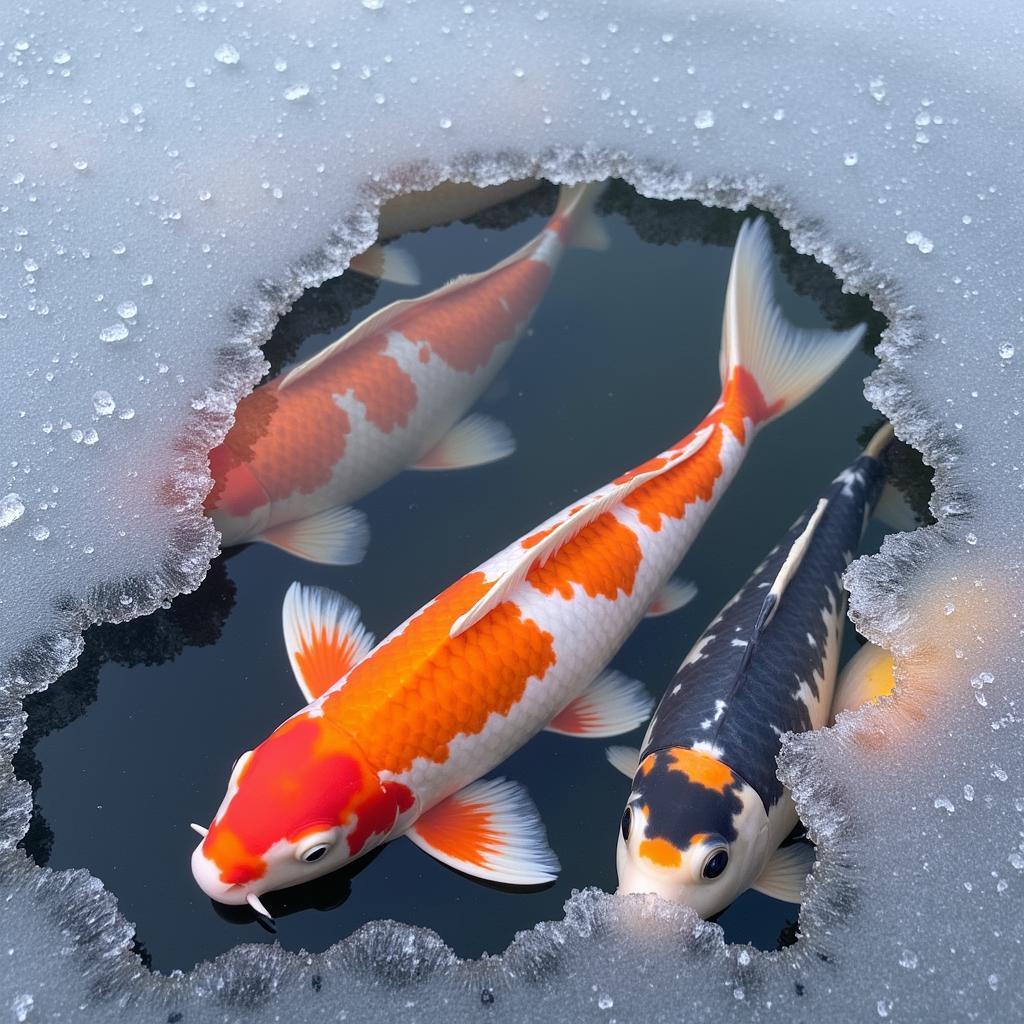As the leaves turn vibrant hues of red and gold, and the air takes on a crisp, cool edge, it’s time to consider how these changes affect our finned friends. Fall Koi Food plays a crucial role in preparing your koi for the colder months ahead. Providing the right nutrition now will ensure they emerge healthy and vibrant in the spring.
Choosing the right fall koi food isn’t just about grabbing any bag off the shelf. As the water temperature drops, your koi’s metabolism slows down, and their nutritional needs change. They require a diet lower in protein and higher in carbohydrates to build up essential energy reserves for the winter. Understanding these changes is key to selecting a food that supports their health and well-being during this transitional season. Choosing a food like Hikari Gold Koi Food can be a great choice as temperatures cool.
The Importance of Seasonal Koi Diets
Just as our own appetites shift with the seasons, so too do those of our koi. In the summer, when water temperatures are warm and koi are most active, they require a high-protein diet to fuel their growth and energy levels. However, as fall approaches, and water temperatures begin to decline, their metabolism slows, and their nutritional needs change dramatically. Feeding a high-protein diet during the cooler months can lead to digestive issues and a weakened immune system, making them more susceptible to disease.
Tailoring Your Koi’s Diet to the Falling Temperatures
As the temperature drops below 50°F (10°C), your koi’s digestive system becomes less efficient. This is when you should switch to a wheat-germ based food, specifically designed for cooler water temperatures. These specialized formulas are easily digestible and provide the essential nutrients your koi need to maintain their health throughout the winter. The right fall koi food allows your koi to store energy reserves and bolster their immune system, preparing them for the challenges of the colder months.
Selecting the Right Fall Koi Food
With so many koi food options available, choosing the right one can feel overwhelming. Look for a fall koi food that is lower in protein (around 30-35%) and higher in carbohydrates. Wheat germ is an excellent source of easily digestible carbohydrates, providing the energy your koi need to survive the winter. Also, consider the size and age of your koi. Smaller koi and younger fish may require a smaller pellet size for easier consumption.
Key Nutrients for Fall Koi Health
Essential fatty acids, such as omega-3 and omega-6, are crucial for maintaining cell membrane health and boosting the immune system. Vitamins and minerals, such as vitamin C and zinc, also play a vital role in supporting immune function and overall health. A high-quality fall koi food will contain a balanced blend of these essential nutrients. For larger ponds, buying in bulk, like pond fish food 50 lb, can be more economical.
Common Fall Koi Feeding Mistakes to Avoid
Overfeeding is one of the most common mistakes koi owners make, especially during the fall. Remember, your koi’s metabolism is slowing down, so they require less food. Overfeeding can lead to poor water quality and increase the risk of disease. Another common mistake is feeding the wrong type of food. Avoid feeding high-protein foods during the fall, as these can be difficult for your koi to digest in cooler water temperatures. It’s also important to note that other pond inhabitants, like other fish or even turtles, have different dietary needs than Koi. For example, you should research whether can pond fish eat dog food before feeding any to them.
“A gradual transition to a fall-specific diet is crucial for koi health,” says renowned aquatic veterinarian, Dr. Emily Carter. “Sudden changes in diet can stress the fish and compromise their immune system.”
Preparing Your Koi for Winter Dormancy
As winter approaches and water temperatures consistently fall below 50°F, your koi will enter a state of dormancy. At this point, they will stop feeding altogether. It’s essential to stop feeding your koi when the water temperature reaches this point, as their digestive system will become inactive.
 Koi in a Winter Pond
Koi in a Winter Pond
Conclusion
Choosing the right fall koi food is an essential part of responsible koi keeping. By understanding your koi’s changing nutritional needs and selecting a high-quality, seasonally appropriate food, you can help them thrive throughout the fall and prepare them for a healthy winter. Proper fall koi food sets the stage for a vibrant and active spring season.
“Providing the right nutrition is an investment in your koi’s long-term health and well-being,” adds Dr. Carter. “A well-nourished koi is a happy and resilient koi.”
FAQ
- When should I switch to fall koi food? When water temperatures consistently fall below 60°F (15°C).
- What is the ideal protein level for fall koi food? Around 30-35%.
- Why is wheat germ a good ingredient in fall koi food? It provides easily digestible carbohydrates.
- Should I continue feeding my koi throughout the winter? No, stop feeding when water temperatures drop below 50°F (10°C).
- How can I avoid overfeeding my koi in the fall? Feed smaller amounts more frequently and monitor their feeding habits.
- What are the signs of a healthy koi in the fall? Vibrant colors, active swimming, and a good appetite.
- What should I do if my koi stops eating in the fall? Check the water temperature and quality, and consult with a veterinarian if necessary.
Need more help? Contact us at Phone Number: 02437655121, Email: minacones@gmail.com Or visit us at: 3PGH+8R9, ĐT70A, thôn Trung, Bắc Từ Liêm, Hà Nội, Việt Nam. We have a 24/7 customer service team.